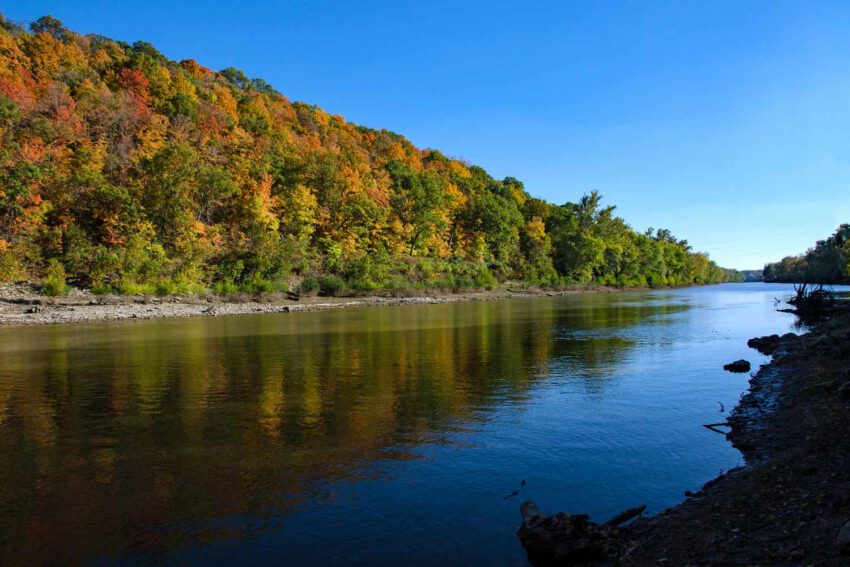Far below the surface of Missouri, a state that is perhaps best known for Kansas City-style barbeque, Anheuser-Busch, and an odd collection of extremely large objects, there’s an entirely other world — an underground world.
“The Cave State” is nicknamed for the 7,500 recorded caves that sprawl below it — including a vast network under St. Louis. But while the caves below St. Louis are largely inaccessible, just an hour southwest of the city is the iconic underground world of Meramec Caverns and the 40-plus caves of Meramec State Park.
Getty Images
The caves are easily the Meramec Valley’s biggest draw, but in the fall, half of the appeal is found above the surface of the Earth, when Missouri’s maples, ashes, hickories, and oaks start to change colors. In Meramec State Park, you can catch the colors and pass by several of the park’s caves on the Natural Wonders Trail before making the 15-minute drive to Meramec Caverns.
Courtesy of Missouri State Parks
Home to the largest cave west of the Mississippi, Meramec Caverns has some of the rarest and largest cave formations in the world, including the ancient limestone “wine table” formation. The caves are impressive on their own, but part of what makes them such an interesting place to visit is the role they have played in history.
The initial cave was first used by the Osage Nation as a refuge from extreme weather. It was then mined for saltpeter, aka potassium nitrate, and used as a Union-held gunpowder manufacturing plant during the Civil War. In addition, according to local lore, the cave was the second-to-last-stop on the Underground Railroad.
In the 1890s, the cave saw a dramatic shift. It became a destination for underground parties, which allowed locals to escape the summer heat. Partygoers turned the large room near the entrance into a giant dancefloor nicknamed “the ballroom.”
Courtesy of Missouri State Parks
Meramec Caverns became a true show cave and tour site when it was purchased by Lester Benton Dill in 1933. While working in his cave, Dill found a crevice leading to an upper level. The discovery included what became known as “the stage curtain,” the largest single cave formation in the world at 70 feet tall and 35 feet thick. Dill used it as the backdrop for his shows and it remains one of the top sights in Meramec Caverns today.
Later, in the summer of 1941, Dill made a second discovery — this one so big it made Meramec Caverns famous. He found an opening that led to another cave containing rifles, shackles, and strong boxes that could be traced to the train robbery at Gadshill, Missouri, performed by the infamous outlaw Jesse James. In addition to the physical evidence found in the cave, sheriff and eyewitness accounts confirmed that James used the cave as a hiding place.
Courtesy of Missouri State Parks
Thanks to all of Dill’s discoveries, there are seven levels of caves to explore — all loaded with history. The caves and their stories are safeguarded by the descendants of Dill, who continue to own and operate Meramec Caverns.
Tours of Meramec Caverns take place daily (except for Thanksgiving and Christmas) with a trained ranger. Above ground, the Meramec Cavern complex includes a campground and a motel, in addition to a zip line, climbing wall, and riverboat tours.
